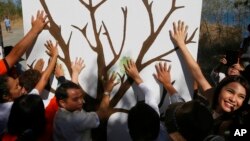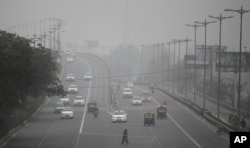Organizers of Earth Day, celebrated each April 22, say more than one billion people are marking Earth Day 2016 with activities to promote environmental protection.
The day is used as a time to organize various communities - school groups, neighborhoods, faith communities and more - to take part in such activities as local cleanups, tree plantings, meetings with political officials and educational events.
While world leaders are commemorating the day with the signing of the Paris Climate Agreement at U.N. headquarters in New York, Susan Bass, senior vice president of the Earth Day Network, says environmental activists are marking the day in nearly 200 countries.
Bass says times have changed since the first Earth Day in 1970, dreamed up by a U.S. senator dismayed by the effects of a massive oil spill in Santa Barbara, California a year earlier.
Focus on climate change
In 1970, Bass says, "our rivers were on fire, the skies were black. There was a very visible pollution that everyone could see." Now, she says, the focus is climate change, which is a more subtle issue. She says organizers' focus is on education and grassroots activism, especially in pollution-challenged places like China and India.
Yet, challenges also remain in the United States where the Santa Barbara oil spill that inspired the first Earth Day is now considered the third-largest spill in U.S. waters. It was surpassed in 1989 by the Exxon Valdez spill in Alaska, and in 2010 by the even larger Deepwater Horizon spill in the Gulf of Mexico.











